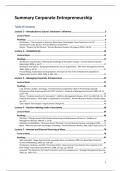Summary Corporate Entrepreneurship
Table of Contents
Lecture 1 – Introduction to Course: Innovator’s Dilemma ...................................................3
Lecture Notes .......................................................................................................................... 3
Readings .................................................................................................................................. 6
Christensen, “The Innovator’s Dilemma: When New Technologies Cause Great Firms to Fail”, ..................6
(introduction only), Boston: Harvard Business School Press. ........................................................................6
Moore, “Darwin and the Demon,” Harvard Business Review, July-August 2004, p. 86-93. ..........................8
Lecture 2 – Ambidexterity ...............................................................................................12
Lecture Notes ........................................................................................................................ 12
Readings ................................................................................................................................ 17
Christensen and Overdorf, “Meeting the Challenge of Disruptive Change,” Harvard Business Review,
March-April 2000, p. 66-77. .........................................................................................................................17
Birkinshaw and Gibson, “Building Ambidexterity into an Organization,” MIT Sloan Management Review,
2004, 45(4), p. 47-55. ...................................................................................................................................21
He and Wong, “Exploration and Exploitation: An Empirical Test of the Ambidexterity Hypothesis”,
Organization Science, 2004, 15(4), p. 481–494. ...........................................................................................24
Lecture 3 – Managing Corporate Entrepreneurs ..............................................................27
Lecture Notes ........................................................................................................................ 27
Readings ................................................................................................................................ 35
Ling, Simsek, Lubatkin, and Veiga, “Transformational Leadership’s Role in Promoting Corporate
Entrepreneurship: Examining the CEO-TMT Interface,” Academy of Management Journal, 2008, Vol. 51
p.557-576. .....................................................................................................................................................35
Manso, “Creating Incentives for Innovation”, California Management Review, 2017, Vol. 60(1) 18- 32. ..39
Podolny and Hansen, “How Apple is Organized for Innovation”, Harvard Business Review, Nov/Dec 2020,
pp. 1-11. ........................................................................................................................................................44
Case: Agilent Technologies: Organizational Change (A)...............................................................................49
Lecture 4 – Decision Making Under Uncertainty ..............................................................59
Lecture Notes ........................................................................................................................ 59
Readings ................................................................................................................................ 68
McGrath, “Falling Forward: Real Options Reasoning and Entrepreneurial Failure,” Academy of
Management Review 1999 24:1, 13-30. ......................................................................................................68
McGrath and MacMillan, “Discovery Driven Planning,” Harvard Business Review, July-August 1995. ......71
Blank, “Why the lean start-up changes everything,” Harvard Business Review, May, 2013, 91(5): 63-72. 74
Lecture 5 – Internal and External Sourcing of Ideas ..........................................................76
Lecture Notes ........................................................................................................................ 76
Readings ................................................................................................................................ 87
Sethi and Iqbal, “Stage-Gate Controls, Learning Failure, and Adverse Effect on Novel New Products”,
Journal of Marketing, 2008. pp. 118-134. ....................................................................................................87
Christensen, Kaufman, and Shih “Innovation Killers: How Financial Tools Destroy Your Capacity to Do
New Things” Harvard Business Review, 2008, January, pp. 98-105. ...........................................................93
Danneels “The Dynamics of Product Innovation and Firm Competences”, Strategic Management Journal,
2002, pp. 1095-1121.....................................................................................................................................97
1
,Lecture 6 – Sourcing External Knowledge ...................................................................... 103
Lecture Notes ...................................................................................................................... 103
Readings .............................................................................................................................. 105
Audretsch and Belitski. “The Limits to Open Innovation and its Impact on Innovation Performance”,
Technovation, 2023, 102519. .....................................................................................................................105
Chesbrough, “Making Sense of Corporate Venture Capital,” Harvard Business Review, 2002, March. ...108
Danneels and Miller “Corporate venture capital contributions to strategic renewal: Neglected paths and
barriers”, Strategic Entrepreneurship Journal, 2023, 17(3), 560-584. .......................................................112
Lecture 7 – Guest Lecture ASML .................................................................................... 118
2
,Lecture 1 – Introduction to Course: Innovator’s Dilemma
Why do large successful companies sometimes fail when confronted with disruptive changes in their
environment? This week, we will discuss a number of possible reasons, including the idea that
missing the boat can happen because of good instead of poor management.
Lecture Notes
Corporate entrepreneurship: the study of entrepreneurial behavior within established organizations
Large firms missing the boat
The fall of Nokia example shows:
- It’s hard to remain innovative
- Making wrong choices in terms of partners, etc. (strategic decisions) is likely in times of
change
- Easy to say it now, but you don’t know it then at that moment
Nokia is not the only firm (Kodak, Blackberry, Yahoo, Free Record Shop, etc.)
- They knew that change was coming and this change conflicted with their current way of
doing business (e.g. Kodak to make digital cameras)
o Not the reasons: “we cannot do it, because of time/technology/etc.”, but other
reasons often cause the fall. That’s what this course is about
Typologies of technological change:
- Old vs. new
- Competence-enhancing vs. competence-destroying
- Incremental vs. radical
- Sustaining vs. disruptive
o Disruptive innovation is more harmful for firms to remain innovative, because it is
difficult to invest in. They cannot deal with it
→ It is especially the latter types of change that large established firms have difficulties coping with.
Why? Success Syndrome
- Fit: offering something that the customer wants
- As the company becomes more successful, the company grows. The size and age are going
to increase → This leads to 2 types of inertia:
o Structural inertia (size)
o Cultural inertia (age)
- This typically slows down the company
- Although it’s something good: you’re at the peak (success). But you have to change the
business model
o People are resistant to change (stakeholders need to change along too)
3
, Is inertia always bad?
- Inertia may result from accountability and reliability
- How to protect the traditional successful business and to engage in radical innovation at the
same time?
- Important to look at both past/current and future situation
Video Steve Ballmer on the expected success of Apple: inertia can be detrimental
- Few years later he did another interview
o “We were software guys” not phone guys
o Customers asked software from us, not hardware
The Innovator’s Dilemma
According to Clayton Christensen, failure to adapt to disruptive innovation is not the result of bad
management, but a result of good management
- Large companies depend on their existing customers and investors for resources
- They listen closely to these customers and investors and kill ideas for which there is little
need
- Product performance: what can a particular product do?
- New technology in the beginning is not working as well as an existing technology
- A company will be placed on one of the arrows as long as they keep working with the same
technology (upper arrow: old technology, lower arrow: disruptive technology)
o Firms can go to the other line, but many times, firms will not make this jump
because of the reasons why it’s hard to innovate (inertia)
- The letters (A-E) represent points where a company can be
o A: not making everyone happy, but for regular products, it’s good enough
4





